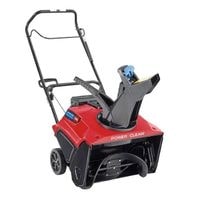Toro Snowblower Troubleshooting. Toro is a manufacturer of lawn and garden products such as snowblowers, mowers, tractors, and tillers. Most consumer-targeted snow throwers are single-stage, gas-powered machines.
If your Toro snowblower fails to start, you can use the troubleshooting tips below in order to fix it. Fixing your Toro snow thrower can help save you time and money over having all of the repairs done at a shop.
Toro Snowblower Troubleshooting
Here we will discuss some common issues and solutions for Toro Snowblower Troubleshooting.
Only one auger turns
Sometimes the blower will only work on one auger but it might be because of a defective shear bolt.
A shear bolt is a metal bolt that slides through the auger axle sleeve, locking the sleeve in place with the auger drive axle.
A shear bolt is designed to break in half if it hits a rock or chunk of ice so as to prevent damage to the engine. If your shear bolts are damaged or broken, you won’t be able to turn your augers and therefore can’t blow snow with them.
The best way to tell if your shear bolts are broken – inspect them for cracks and make sure they’re fully inserted into either your velvety coating or your plating!
Starts then stalls problem
This issue commonly arises due to a clogged carburetor. A clogged carburetor is most commonly caused by leaving fuel in the snowblower for a long period of time. Over time, some of the ingredients in the fuel may evaporate, leaving behind a thicker, stickier substance.
This sticky fuel can clog up the carburetor and cause the engine to stall. If the carburetor is clogged, try cleaning it with carburetor cleaner. If cleaning the carburetor isn’t effective, rebuild or replace the entire carburetor.
As fuel is consumed by the engine, the level in the fuel tank lowers. To make up for this, the fuel cap uses a small vent to allow air to enter the tank. If the fuel cap vent is clogged, air won’t be able to enter the tank and a vacuum or “vapor lock” will occur.
This stops the flow of fuel to the carburetor causing bad starting or stalling. To determine if the fuel cap vent is clogged, try slightly loosening it. If this helps resolve symptoms then it’s likely clogged with dirt and will need to be replaced.
Toro Snowblower’s engine runs rough
If your Toro Snowblower’s engine runs rough inspect the spark plug to see if it is worn or damaged. If there are signs that the porcelain insulator is cracked, an electrode is burned away, or there is heavy carbon buildup at the electrode, change out your spark plug.
To tell if a spark plug has been damaged, you can use a spark tester. You should see a strong spark between the tester’s terminals when the engine starts cranking. If not then it may mean you need to put in a new one!
The engine oil might have been overfilled. If the engine oil is too high, it could overflow out of the breather tube and seep into the carburetor.
If this has occurred, take apart the carburetor thoroughly and clean it well to get rid of any traces of oil residue. Ensure there is a correct amount of engine oil left in after performing this operation!
Wheels are not engaging
The drive belt connects the engine to its wheels in order for them to move. The drive belt can be broken, worn out or off track, so take a moment to inspect it accordingly.
Remove any kinks or align the belt properly. If the belt or its components aren’t working properly, replace it as soon a possible.
Snowblower’s starting issue
In order for the spark plug to work properly, a high voltage needs to come from the ignition coil. To test whether or not the ignition coil is sending out enough high voltage, use an ignition tester. The tester should measure a voltage.
If there is no high voltage being tested, you can try replacing the spark plug first and seeing if that fixes the problem before checking to see if the ignition coil is malfunctioning.
If it shows no change even after replacing the spark plug and measuring high voltages again then this means that you’re now dealing with a faulty ignition coil (rather than a faulty sparkplug).
Related Guides
